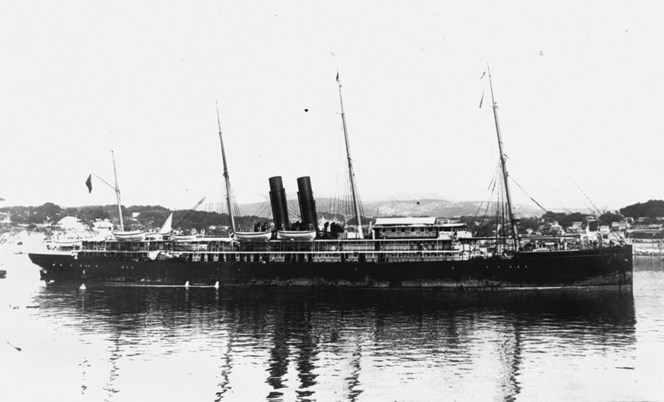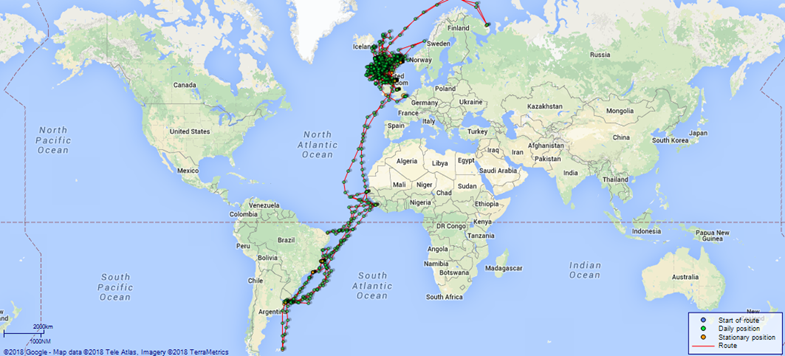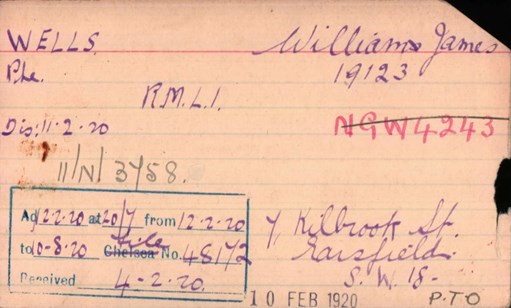William Wells: A War at Sea and on Land
- Home
- World War I Articles
- William Wells: A War at Sea and on Land
A friend has in recent years been researching his family history and knowing of my interest in World War One enlisted my help to research the military careers of his ancestors. One, his great uncle, Corporal Charles Franklin, was killed at Arras on 9 April 1917 and on the 105th anniversary of his death I was able to take him to see the battlefield and Charles’ grave, which was particularly gratifying.
Meanwhile his grandfather, William James Wells, had the family story that he had served in Russia, and at some stage acquired a pet parrot (not from Russia presumably!) that my friend remembers seeing it in an old photograph in his parent’s home many years ago. There was also mention of chasing the Graf Spee, and of William having a shoulder wound / injury.
This seemed to be a research challenge worth tackling, but knowing of how wildly wrong many family stories are I was a little sceptical, however...
William Wells was a 17 year-old Chemist’s Assistant from Earlsfield, London, when he enlisted into the Royal Marines(RM) on 16 September 1914. During his training at the RM Depot in Deal, Kent, he no doubt heard of the exploits of the Royal Naval Division (RND) at Antwerp in October 1914, and its subsequent return, much depleted in numbers, to the UK. He would have probably expected to be posted to one of the marine battalions serving in the RND. However, possibly as a result of his age, he was posted to Chatham in January 1915, where he attended a gunnery course, which took his career in a different direction.

Above: William Wells, Royal Marines. Photograph courtesy of the Wells family.
As well as their land-based role the RM provided small detachments for most Royal Navy ships, where their role could include being gunners, or providing boarding parties to search suspect vessels. William was posted to HMS Orotava on 14 April 1915 and was almost certainly amongst the four marines reported as joining the ship at Glasgow three days later, bringing the RM compliment to 22 men.

Above: The former Pacific Steam Navigation Company liner 'Orotava'. In 1906 she passed to the Royal Mail Steam Packet Co.
The Orotava was built in 1889, displaced 5,857 tons, was 430 feet long and had a speed of 14.5 knots. Originally built for the Liverpool to Valparaiso (Chile) service, after just two voyages she was transferred to the Orient Line for service to Australia. In 1896, while coaling at Tilbury, she capsized with the loss of four lives, but was refloated, refurbished and resumed service. Between 1899 and 1903 she was used as a troop ship for voyages to and from the South African war, before returning to the Australia service in March 1903. Three years later she transferred to the Royal Mail Line, still on the Australia service. In March 1909 she commenced her last Australian voyage before transferring to West Indies routes. In 1914 she was requisitioned and converted to an armed merchant cruiser with 5 x 6-inch and 2 x 6-pounder guns, before joining the 10th Cruiser Squadron in early 1915.

Above: HMS Orotava. Picture - Wikipedia
The 10th Cruiser Squadron was responsible for patrolling the northern waters off the UK and William’s first patrol began on 21 April 1915and lasted for two weeks, during which a number of vessels were stopped and inspected to ensure they were not carrying cargo destined for Germany. This was followed by a week re-supplying and re-coaling back in Glasgow. A similar pattern was continued until the beginning of November 1915 when the Orotava set sail for Russia, arriving at Yukanski Harbour (modern day Ostrovnoy, about 200 miles south-east of Murmansk) on 10 November. So, the family story about William serving in Russia was proved right.
At Yukanski she unloaded supplies and took on board ammunition from HMS Arlanza that had recently hit a mine and been recovered to the harbour. Three days later the Orotava sailed for Glasgow with the captain and 251crew from the Arlanza, as well as a Russian naval and military delegation that had been on the Arlanza and were due to attend a conference in Britain. About 100 men of the Arlanza remained to carry out temporary repairs and she was eventually able to make it to Belfast with the aid of a tug in July 1916.
The Orotava then resumed her patrolling, although in mid-January 1916 she started a cycle of returning to Glasgow after one patrol and then to Busta Voe, Shetland, after the next. Loch Ewe was also an occasional stopping point. At the beginning of November, the Orotava underwent an overhaul in dry dock, before setting sail for Sierra Leone on 29 November, arriving at Freetown on 12 December. After a period patrolling off West Africa the Orotava sailed southwest to the River Plate between Uruguay and Argentina.
This may account for the mention of the Graf Spee which was chased into the River Plate and subsequently scuttled off Montevideo; but this was a WW2 action and stories of William’s visit 23 years earlier may have become mistakenly linked in later years. Orotava continued patrolling the east coast of South America and across to West Africa; in late May 1917 she even ventured as far south as the Falkland Islands. At the beginning of July, the Orotava spent two weeks in a floating dry dock at Rio De Janeiro for repainting and repairs and, with most men being allowed ashore, this is possibly where William acquired his pet parrot. Further patrolling off South America continued until mid-August when the Orotava headed across the Atlantic for Dakar, and then on to Glasgow, arriving in mid-September.
The Orotava remained at Glasgow and was paid off at the end of November 1917, but William had already left the ship and gone to Chatham a couple of weeks earlier. While there he attended bombing and machine gun courses, before being transferred to the RM Brigade of the RND on 4 February 1918 – his war was to now be very different from his previous three year’s service. It is unknown which battalion he served with, but with the Chatham connection it was most likely the 1st Battalion, Royal Marine Light Infantry (1/RMLI), and their first mention of reinforcements arriving after that date was on 19 February. At the time the RND were rotating their battalions in and out of the line south-west of Cambrai. On 19 March 1/ RMLI took over the front line at the centre of the Flesquières Salient.

Above: a map of the voyages undertaken by HMS Orotava. Photograph – Naval-net
The Germans launched their massive offensive two days later and 1/RMLI were ordered to retire back through 2/RMLI in the support line, which then became the new front line. Although heavily shelled, the Germans did not mount any significant infantry attacks as their plan was to ‘pinch out’ the base of Flesquières Salient and trap the four divisions holding the perimeter.
The following day 1/RMLI retired back to the old British front line at Havrincourt Wood, and thereafter through Bertincourt, Martinpuich, and Hamel. Then, during a short stay at Martinsart, two companies took part in an attack at Mesnil and Aveluy Wood to repel German patrols infiltrating the area. 1/RMLI’s War Diary gives casualties over the period 22 – 28 March as 20 men killed; 5 officers and 78 men wounded and 7 officers and 337 men missing.
After two more weeks on the Somme front 1/RMLI were rested for several weeks before returning to Hamel in early May. The battalion remained in the Hamel area, rotating in and out of the line, until late August when they moved south-east to Loupart Wood, near Bapaume, where they mounted a successful attack and captured 150 prisoners, but at a cost of more than 270 casualties.In late September 1/RMLIwas involved in operations on the Canal Du Nord and the Hindenburg Line at Anneux, west of Cambrai and, after advancing steadily, they finished their war near Mons.
William Wells was posted back to Chatham in August 1919 and invalided out of the marines in February 1920, although his records do not indicate the reasons why, and he appears to have only received a pension for six months. He no doubt had many happy tales from his travels to exotic places during the war; as well some tragic ones from his nine months service on the Western Front. He died in 1973.

Above: the Pension record card for William Wells
Note: Further information on the voyages of the Orotava, and indeed many other ships, can be found at www.naval-history.net
Article contributed by Derek Bird





